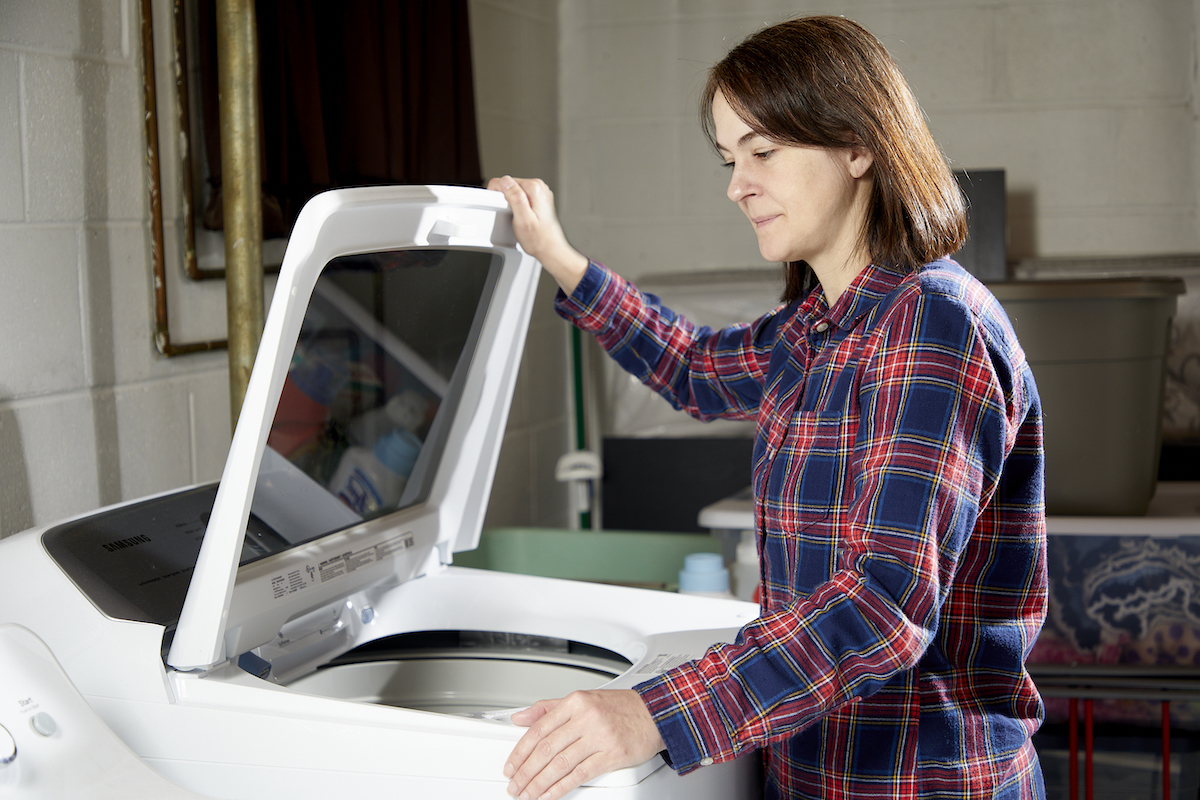

We may earn revenue from the products available on this page and participate in affiliate programs. Learn More ›
Over time, unpleasant odors can emanate from a washing machine. These smells can have a number of different causes. “A common reason for odor is mildew,” says William McGrath, an appliance tech specialist at AppliancePartsPros.com. He adds that other potential causes include “any residues that may have been attached to clothing, as well as softener or detergent buildup.”
All this residue, along with soap scum, dirt, body oil, and hair, gets trapped inside the washer’s seals, gaskets, and dispensers. Combine this noxious concoction with the constant humidity of a laundry room and you can end up with an ideal environment for bacterial growth. And therein lies the irony: The machine we rely on day after day, cycle after cycle, to remove soil and stains can wind up smelling worse than the dirty laundry. To get your appliance back on track, you may need to clean your washing machine thoroughly.
Ahead, discover where mildew and bacteria are likely to lurk in front-load and top-load machines, and the best methods for removing the odor-causing residue.
Why Does My Washing Machine Smell?
There are a number of reasons your washing machine develops unpleasant odors, including:
- Built-up mold or mildew
- Accumulated residue
- A drainage issue
- Using the wrong type or amount of detergent
- A dirty lint filter
Front-Load vs. Top-Load Washing Machines
The two primary types of washing machines, front-load and top-load, have distinct features and benefits. When it comes to odors, however, McGrath notes that “the rubber door seal of a front-load washer can [cause it to develop] mildew more readily than a top-load washer due to it potentially having water sit in a fold.”
- If you have a front-load washing machine, be sure to regularly wipe around the rubber gasket with a damp cloth, and use a cotton swab to remove accumulated gunk from tight places around the gasket.
- On top-load washing machines, pay special attention to the cracks and crevices around the doors where dirt tends to hide.
How to Clean a Washing Machine That Smells
Before you start scrubbing, remove detergent bottles and other laundry supplies from the top of the washing machine, make sure the machine is empty, and unplug the unit. Sniff around and inside the machine to see if you can pinpoint the source of the odor, and have a helper nearby in case you need to move the washing machine away from the wall.
These next steps will help to remove foul odors from your washing machine.
Step 1: Remove and scrub the detergent dispensers.
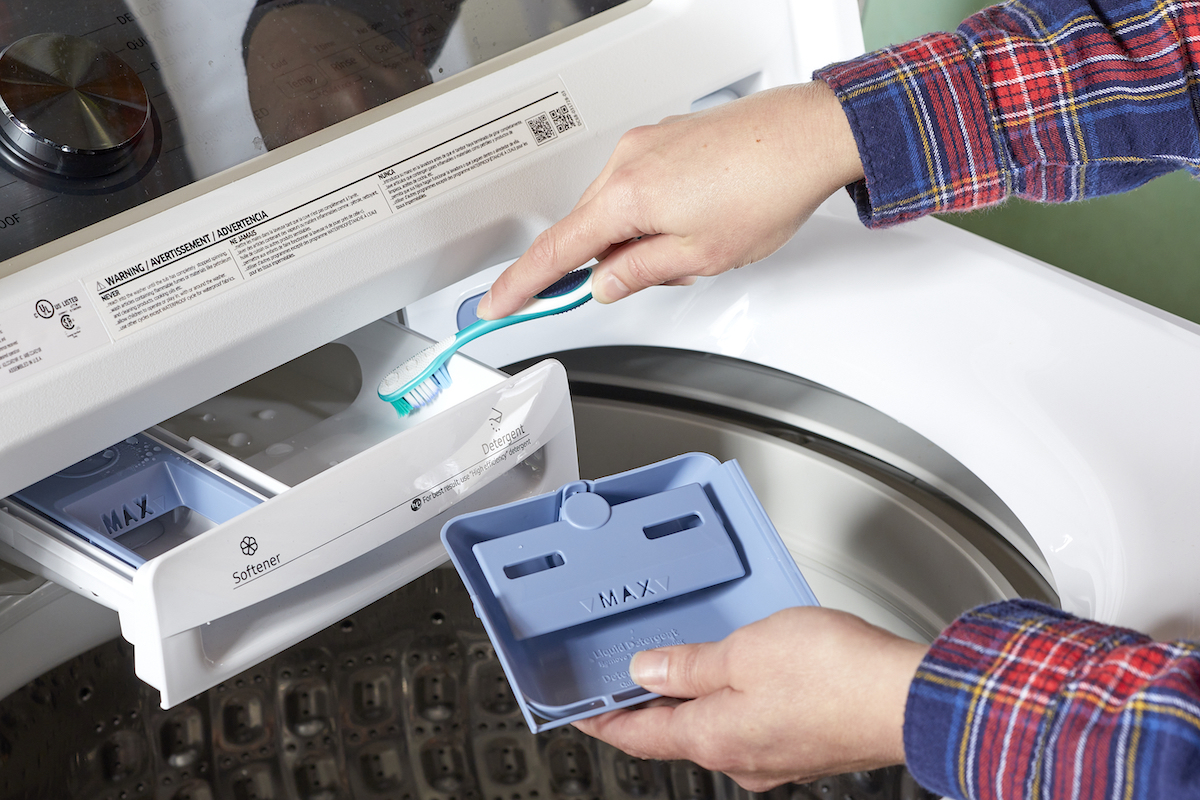
If your washing machine smells like mildew, one of the first things to do is remove and clean the soap, bleach, and softener dispensers. Any water left standing in them between wash cycles offers prime breeding ground for mildew. Depending on the washer you own, you may be able to remove the entire dispenser drawer for easier cleaning; check your user’s manual.
Wash the dispensers with warm water, using an old toothbrush to get inside the crevices. Use a pipe cleaner to clear buildup out of dispenser tubes. Let the dispensers dry out completely before putting them back in the machine.
Step 2: Sanitize the washing machine.
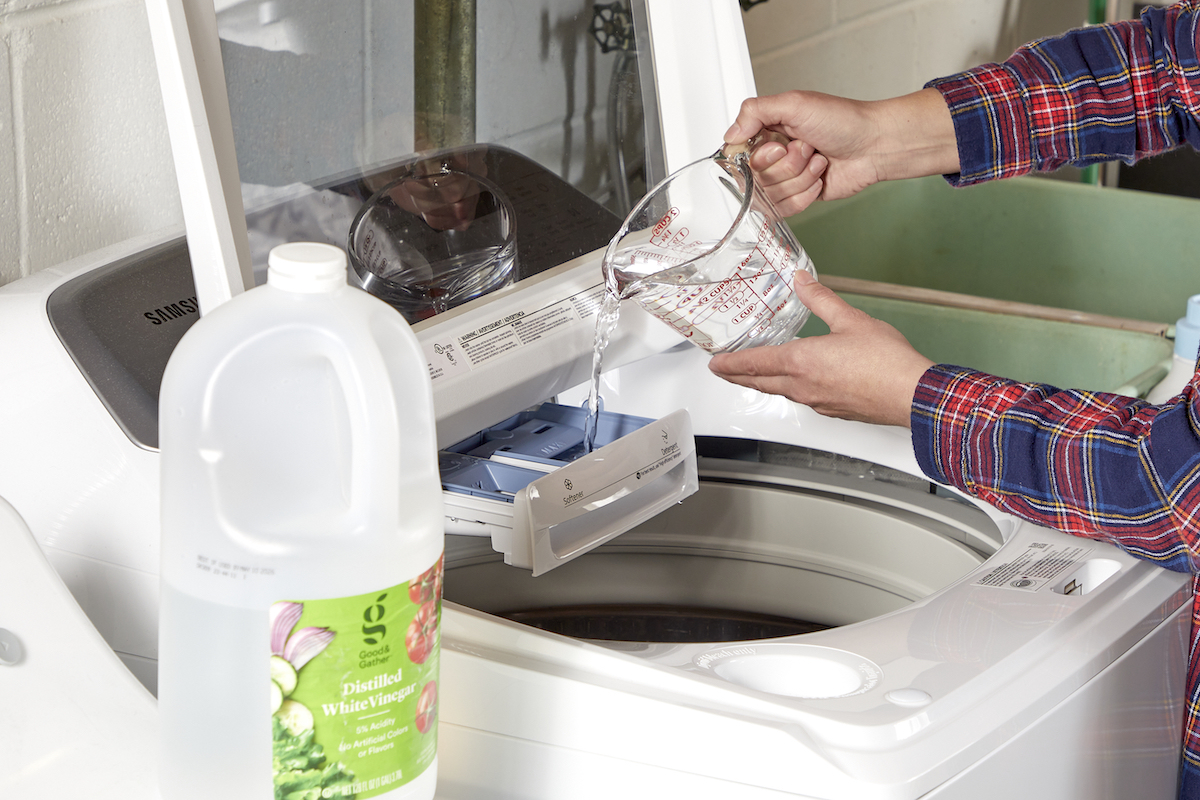
While chlorine bleach and vinegar can both be effective for cleaning a washing machine, never use the two cleaners together. Combining bleach and vinegar is very dangerous. Pick one or the other.
These instructions explain how to use bleach or vinegar while running a cycle of hot water through the washer. Some newer washing machines have a special cleaning cycle (look for “Clean Washer,” “Tub Clean,” or a similar cycle name). Before using any cleaner, check the washing machine user’s manual for the manufacturer’s recommendation.
Chlorine bleach is a go-to killing mildew and mold in a washing machine. Be sure to take proper precautions when using bleach, and never mix it with other cleaners. The amount of bleach you use will depend on the type of washer you have.
To clean a top- or front-loading washing machine with bleach:
- Select the highest possible temperature setting, or use your washing machine brand‘s cleaning cycle.
- For a top-loader, add 4 cups of bleach to the drum; for a front-loader, add 2 cups.
- Start the cycle, let the tub fill, and then stop the wash cycle.
- Allow the water-and-bleach solution to sit for 30 minutes, and then resume the cycle.
- Run an additional rinse cycle to remove traces of bleach.
To clean a top- or front-loading washing machine with vinegar and baking soda:

- Select the highest possible temperature setting, or use your washer’s cleaning setting.
- Add 2 cups of white vinegar to the detergent dispenser. If there’s no detergent dispenser, add the vinegar to the washer drum as it’s filling up.
- Run a complete cycle.
- Run another cycle, this time adding ½ cup of baking soda to the drum.
- If odors persist, repeat the process.
Step 3: Rinse the drum with hot water.
After cleaning the washer with either bleach or vinegar, rinse the drum out by running a service wash, a cycle at the hottest setting with the drum empty.
Running a service wash cycle about once a month can help prevent washer smells from coming back. Always ensure your washing machine is empty before starting a service wash. Adding a washing machine cleaner to the cycle will help eliminate even more bacteria and odors than hot water alone.
What if my washing machine still smells?
If your washing machine smells like sewage, even after cleaning, the issue might be a clog in the drain standpipe. The standpipe sits at the back of the machine, so after you turn off and unplug the washer, you’ll probably need to pull the washer away from the wall to access it. Put on gloves and inspect the hose and standpipe for blockages; remove visible lint or debris with a brush or your gloved hands. If the visual inspection comes up empty, grab a drain auger or drain snake and work it slowly into the pipe until you feel some resistance. Push the snake further to grab whatever is blocking the drain.
Once you’ve pushed through the clog, pull out the snake, ideally along with the source of the blockage. If you are unable to remove the clog using the drain snake, try a liquid clog remover.
To confirm the clog is gone, run water down the standpipe. (You can either pour hot water down the pipe or use a garden hose.) If water doesn’t back up, put the washing machine drain hose back into the standpipe, plug in the machine, and run a test cycle. If the standpipe is still backing up, it’s time to call a plumber.
How to Prevent Washing Machine Odors
Now that your machine is clean, let’s keep it that way. A few small changes to your laundering habits will help keep your washer from getting musty again.
Leave the door open between loads.
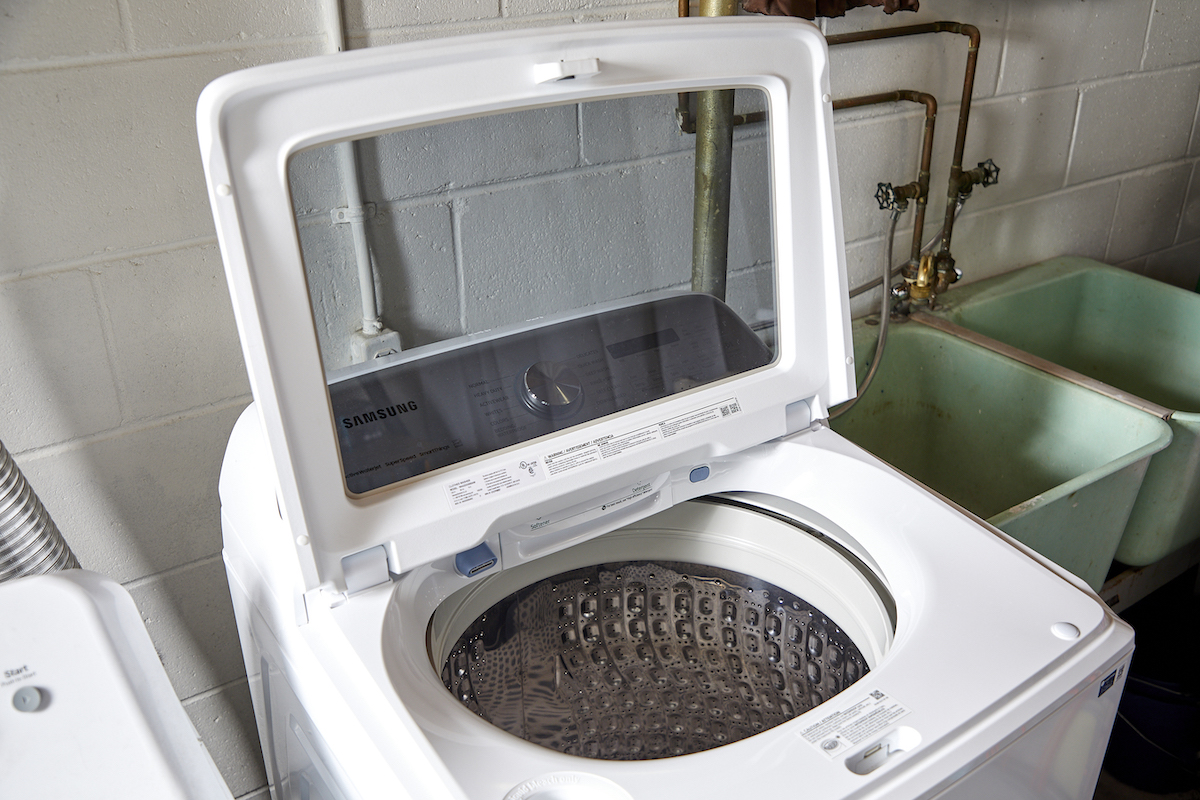
Keeping the door open between washes will give the drum and gasket a chance to dry out. (This is especially important for front-loaders.) It’s a good idea to give the gasket an occasional wipe with a towel moistened in distilled white vinegar or a weak bleach solution, let it sit for a few minutes, and then dry it off.
Use the right kind (and right amount) of detergent and fabric softener.
Today’s high-efficiency (HE) washers require specially formulated HE detergents. Using the wrong type of detergent, fabric softeners, or other additives, or too much or any product, can contribute to residue buildup and odors. Always follow the manufacturer’s instructions and use any measuring cups provided.
Remove wet clothes from the washer promptly.
If your clothes still smell after washing, you may be leaving them in the machine for too long. In fact, this is one of the more common laundry mistakes people make. When wet laundry is left in the washer overnight or longer, mold and mildew can start to grow.
The amount of time it can take for mildew to form on clothing or linens can vary depending on the humidity, temperature, ventilation, and fabric type. But considering how humid and wet a washing machine can be after a wash cycle, to help eliminate the musty smells on clothing, it’s good practice to remove clothes as soon as the wash cycle is finished.
Maintain a routine cleaning schedule.
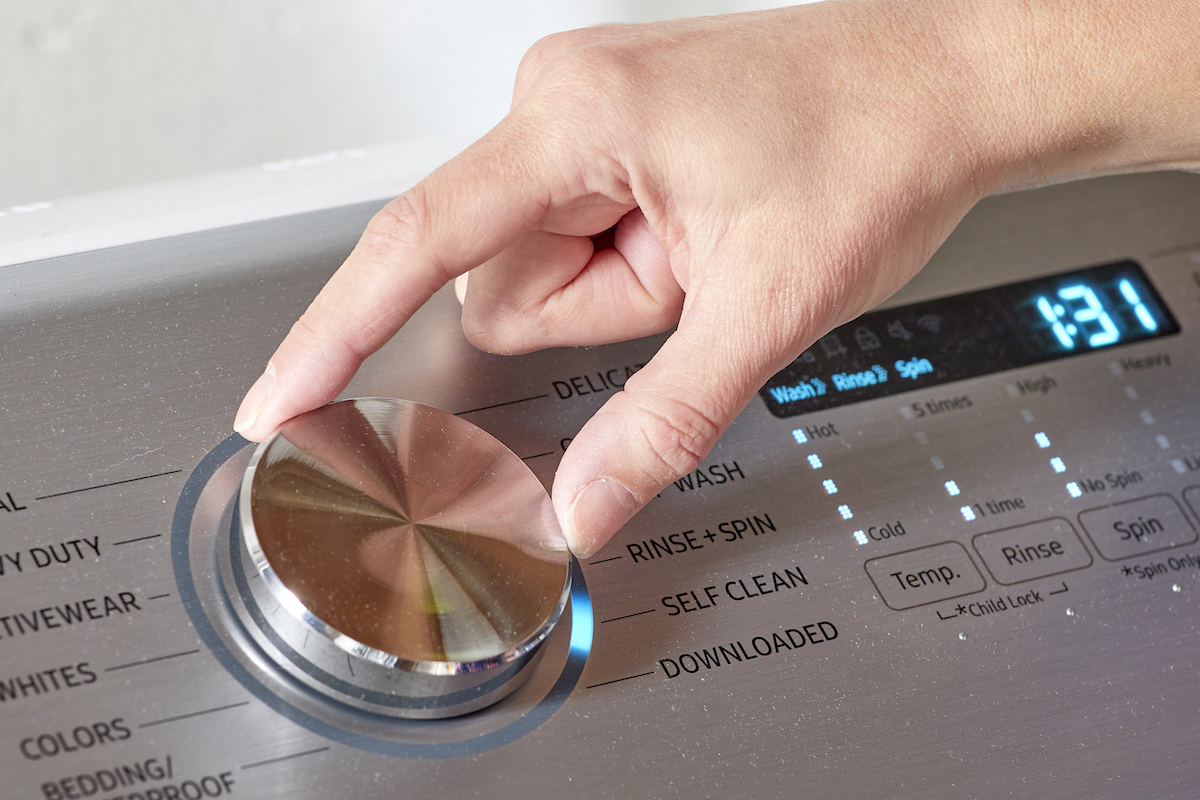
Clean the tub, gaskets, dispensers, and other surfaces to keep smells at bay. “The manufacturer will have a recommended maintenance time frame listed in the use and care guide. However, cleaning a washer once a month can help keep things on a regular schedule that can be easy to keep up with,” McGrath explains.
Clean the drain pump filter and empty the drain tube regularly.
Front-loaders may have a filter and drain tube located on the bottom front of the washer. These are typically accessed via a panel. The water, lint, and dirt trapped in the filter and tube can cause the washer to smell. Follow the manufacturer’s care instructions to keep these components clean.
If you have hard water, try water-softener tablets.
Did you know that having hard water can also lead to laundry odors? Dissolved minerals in hard water can be left behind in the washing machine after each wash cycle. These minerals build up over time, forming limescale.
Limescale can damage the internal components of a washing machine and cause it to malfunction. Additionally, because the bacteria that can live in the built-up limescale have a foul odor, limescale may be the reason your washing machine smells bad. If you have hard water and persistent smells, use water-softener tablets to help prevent limescale buildup.
Once you’ve completed all of these steps, the next time you open your washing machine door, breathe deeply! Instead of that foul-smelling funk, you’ll enjoy the sweet smell of fresh laundry.
FAQs
If your washing machine smells like rotten eggs, there may be hydrogen sulfide gas present, which is produced by bacteria. Follow one of the above methods to clean your washing machine and help mitigate the issue.
There are several reasons your washer may smell like sewage, including trapped moisture or built-up residue. Follow one of the above methods to clean your washing machine and help correct the problem.
